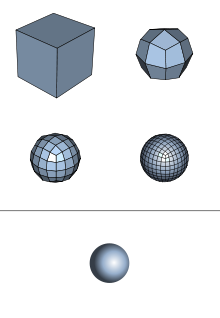Catmull – Clark Subdivision Surface
The Catmull-Clark algorithm is used in computer graphics to create evenly running surfaces by subdivision of surfaces.
The algorithm was developed by Edwin Catmull and James Clark in 1978 . In 2006, Edwin Catmull, along with Tony DeRose and Jos Stam, received the Oscar for technical merits for the invention and development of their subdivision surface method.
functionality
The Catmull-Clark algorithm divides any polygon grids into quad grids (square polygons). Each n-gon is divided into n quads. For example, a triangle polygon is divided into 3 quads and a pentagon polygon into 5 quads. If the starting polygon is already a quad, it is divided into 4 further quads. A repeated application of the algorithm leads to an ever finer mesh. The recalculation of the positions of the corner points is based on the weighting of the old corner points.
Web links
- Description (PDF; 95 kB)
